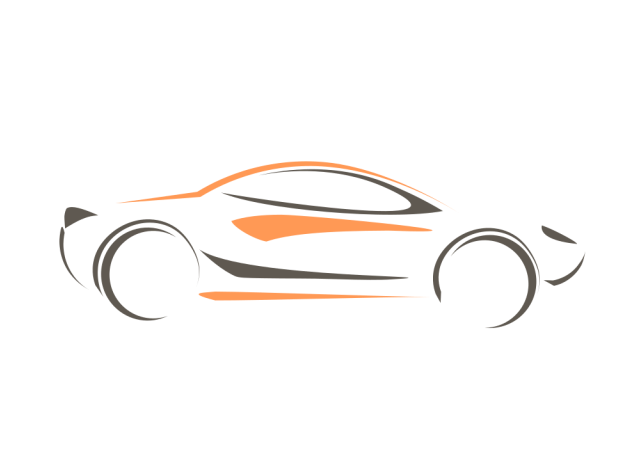Concept Background
“The Ford Start Concept is the first pure concept we’ve developed under our ‘One Ford’ approach,” says Moray Callum, executive director, Americas Design.
“J Mays, Martin Smith and I worked with Freeman and his team to deliver a concept that visually reinforces the fun to drive element that is at the core of the Ford brand DNA.”
Members of the Ford Start Concept design team included:
- Freeman Thomas – design director
- Greg Hutting – technical operations manager
- Tyler Blake – design manager
- Jeremy Leng – design manager
- Jeff Nield – designer
- Matt Edwards – designer
- Andrei Markevich – designer
The Ford Start Concept was inspired in part by a growing global trend toward mass urbanisation. The world’s top 20 mega-cities are home to consumers whose needs, attitudes and expectations may have more in common with mega-city dwellers in other nations than with their own countrymen.
While these consumers share the challenges of living in an urban society, they also increasingly seek out product solutions that bring the best the world has to offer.
These insights inspired Ford designers to envision a future sporty, small-car package geared to their needs and urban mindset.
Today, more than 50 percent of the world’s population lives in an urban area. By 2050, that number is expected to skyrocket to more than 70 percent. Already, congested highways, space for parking, concerns over fuel efficiency as well as the availability and price of fuel are driving automakers to look at vehicles and personal transportation more differently than ever before.
“Our ambition with the Ford Start Concept was to design a car that transcends the practical realities of commuting in these mega cities and goes beyond just dressing the technology. We wanted to design a car you would also love,” explained Freeman Thomas, design director.
Living in the mega city poses unique challenges and inspires unique lifestyles and attitudes. Just as traffic congestion issues are common in these geographic areas, the answers to solve the issues of a new generation of future small cars for these urban markets may also be found in the Ford Start Concept.
“The team has delivered a concept car which reflects a decidedly playful take on Ford kinetic design and builds on our fun-to-drive DNA, yet addresses real issues that everyone will be facing in the future of car design,” said Martin Smith, executive director, Ford Europe and Asia Pacific Design.
As Ford has found with its global ONE Ford strategy, what was once a regional or individual market issue, is now global. Across the world, more consumers are confronting issues including “green” technology, more efficient use of available space, recycling and asking if big is necessarily better. It’s an attitude that unites urbanites around the world.
Searching for efficient power, using lightweight materials that can be recycled and optimising interior space with a small exterior footprint are some of the challenges designers explored.
Could Ford deliver on these challenges, while also creating a concept that would enhance Ford’s fun-to-drive DNA?
At the forefront, Ford has introduced some very real technology in the Start Concept to address fuel efficiency, reduce the use raw of materials and minimize carbon the footprint of a car.
“It may be small with a minimal amount of features but we haven’t ignored the basics like delivering more “traditional” driving characteristics including sporty handling, a simple analogue interface and an interior that is pure and authentic like early sport cars from the 1950s,” Thomas added.
Exterior design
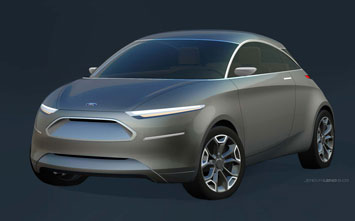 “With the Ford Start Concept, we didn’t set out to design some sort of utilitarian appliance to save the world, nor were we interested in following the competitive trend toward an overly noisy design language.
“With the Ford Start Concept, we didn’t set out to design some sort of utilitarian appliance to save the world, nor were we interested in following the competitive trend toward an overly noisy design language.
«What we did set out to do was design a personality driven car that exudes warmth, charm and aspiration…to design a car worth bonding with,” said J Mays, group vice president Design and chief creative officer, Ford Motor Company.
Crisp highlights are incorporated into a smooth exterior shell constructed with lightweight composite body panels.
The concept is based upon a chassis with a wheelbase that is 2300 millimetres and an overall length under 3700 millimetres. The width is 1672 millimetres with height at approximately 1400 millimetres.
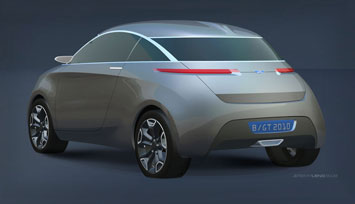 Ford’s trademark kinetic trapezoidal grill moves upward onto the rounded, sleek form, reducing the number of prominent openings from two to one and creating a face that’s both sporting and efficient.
Ford’s trademark kinetic trapezoidal grill moves upward onto the rounded, sleek form, reducing the number of prominent openings from two to one and creating a face that’s both sporting and efficient.
The entire exterior surface of the Ford Start Concept has been designed with flush-mounted aerodynamic features designed to cheat the wind – providing a minimal amount of drag while achieving maximum fuel efficiency.
Efficiency also is evident in the teardrop silhouette and ground plan, in the full aerodynamic underbody and in the reduced cross sectional area.
Flush, stamped aluminium wheels and a subtle fin on the roof, which also houses the centre high mounted stop lamp, complete the aerodynamic detailing.
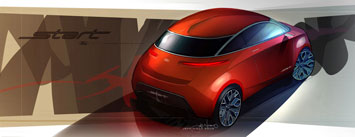 Slim, laser-cut LED headlamps provide high-intensity light through trapezoid tubes. Two sets of running lamps, including a pair located in the headlamp design and a pair of lower running lamps, provide nighttime illumination.
Slim, laser-cut LED headlamps provide high-intensity light through trapezoid tubes. Two sets of running lamps, including a pair located in the headlamp design and a pair of lower running lamps, provide nighttime illumination.
The long, thin upper headlamps sweep from the centre of the fascia into the side of the fender. “digital pulse” turn indicators are housed in the lower running lamp.
The innovative hybrid aluminium, high-strength steel body construction features a lightweight aluminium safety cell that provides a rigid attachment structure for the glass and roof, as well as housing side curtain air bags. All exterior body panels are made from deformable, pre-coloured recyclable composites.
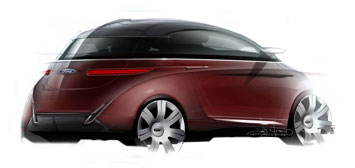 The roof appears separated by glass from the overall body and immediately evokes images of sleek, sporty hardtop designs while providing full panoramic visibility for the driver.
The roof appears separated by glass from the overall body and immediately evokes images of sleek, sporty hardtop designs while providing full panoramic visibility for the driver.
As an added feature, the composite roof panel also is designed to snap fit on the vehicle and could easily be removed and exchanged by the owner as a customised accessory.
All glass is flush mounted for minimal wind resistance, trimmed tightly with brushed steel to accentuate the crisp lines included in the form of the greenhouse. Visibility and driver safety are optimised by recessed B-pillars and see-through C-pillars, plus a wraparound rear window allowing for a 180-degree view.
Like the front fenders, rear quarter panels have a minimal amount of overhang with just 629 millimetres from the rear wheel centre to rear bumper. Rear wheel arches are pronounced and contribute to the overall solid stance of the Ford Start Concept from every angle.
Mirroring the laser-cut front lamp treatment, the LED tail lamps sweep into the decklid and are depressed into a pocket that cuts into the body surface. Included in the rear lamps are integral turn signals with a sequential feature that moves outward from the centre of the lamps when the indicator is applied, providing a sweeping effect.
The rear of the Ford Start Concept is equipped with a traditional boot. The backlight is fixed.
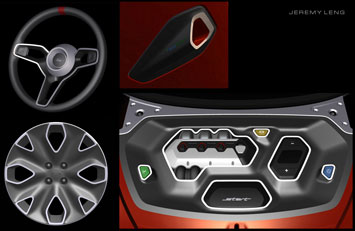 A centre-mounted, cast aluminium tip is fitted to the exhaust pipe to provide a finishing touch.
A centre-mounted, cast aluminium tip is fitted to the exhaust pipe to provide a finishing touch.
The flush, aerodynamic wheels designed for the Ford Start Concept are pressed aluminium measuring 17-by-6.5 inches, fitted with exclusively designed Michelin Green X 205/45R17 tyres. A unique tread design combines to minimise noise, vibration and harshness (NVH) while providing reduced rolling resistance for better fuel efficiency.
To help minimise the aerodynamic inefficiencies found in various pockets and intrusions under the car, the Ford Start Concept is fitted with a full underbody belly pan.
The one-piece pan provides an effective solution to reducing drag from air flow passing under the vehicle. Coarse road noise also is dampened.
Design Overview
For the global design team at the Ford Strategic Concepts Group in Irvine, Calif., it began with taking a step back, reflecting on the complexity and noise in the world around us.
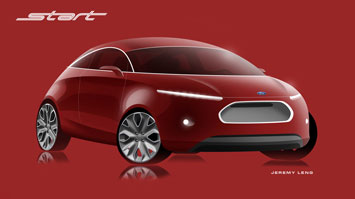 “In an era of constant visual noise, we have created a car that conveys visual purity and harmony, in which every line has meaning and purpose. The Ford Start delivers a dynamic, personality driven design that stays true to the global Ford brand,” said J Mays, group vice president, Design, and chief creative officer.
“In an era of constant visual noise, we have created a car that conveys visual purity and harmony, in which every line has meaning and purpose. The Ford Start delivers a dynamic, personality driven design that stays true to the global Ford brand,” said J Mays, group vice president, Design, and chief creative officer.
The overall design philosophy for the Ford Start Concept was one of making music, not noise. It started with studying the key attributes that contribute to an endearing quality which modern small cars rarely deliver.
The design team brought some inspirational vehicles into the studio to study the attributes that draw people to them, including an original Porsche 356 Speedster and an Alfa Romeo Zagato SZ.
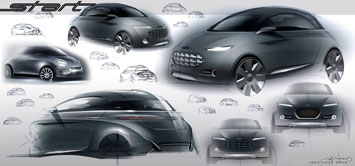 With early sports cars and transportation in general, simplicity and purpose often was the key.
With early sports cars and transportation in general, simplicity and purpose often was the key.
Proportions, stance, silhouette, efficiency and a singular focus on what is really necessary for the driver were priorities – without sacrificing the fun and freedom that driving brought.
“The concept of simplicity can be found all around us,” Mays explains. “Endearing designs in architecture, home furnishings, appliances, transportation, or even a good screenplay are often similar in one respect – simplicity.
«Our vision was to look at a small car holistically, like slicing through an onion where every layer gave meaning, function, and substance to the next. As in nature, taking this approach creates beautiful, endearing objects.”
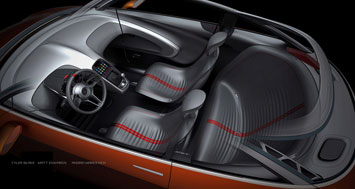 “As a team, we engaged in a philosophical discussion that yielded a common vision. To create a beautiful object that spoke to us emotionally as well as intellectually”, explains Freeman Thomas, design director.
“As a team, we engaged in a philosophical discussion that yielded a common vision. To create a beautiful object that spoke to us emotionally as well as intellectually”, explains Freeman Thomas, design director.
“The exterior design is simple with purposeful proportions and refined surface language normally found on vehicles in premium segments.”
The design team went through a variety of iterations of front end designs to find the right balance and expression.
The team’s objective with the Ford Start Concept was to step back and ask what is really necessary. The result is that there is not a line the design team would wish to add or take away.
The vehicle’s sculptural exterior takes into consideration efficient aerodynamics, from the front fascia, to the flush upper body design elements, and full underbody tray.
Exterior design elements were deliberately kept simple, functional, and consistent. The cars minimalistic approach extends through all of the design details around the car.
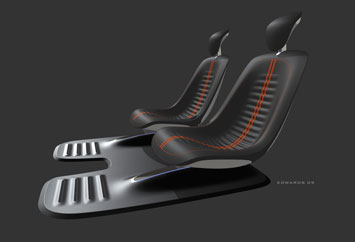 The interior compliments the direction of the exterior. It has been designed to be pure, tactile analog experience.
The interior compliments the direction of the exterior. It has been designed to be pure, tactile analog experience.
“The cockpit is about being the right size with everything you need in the right place,’’ Mays emphasizes. “We concentrated on providing only the information the driver really finds necessary. Great visibility was a major priority as well as driver control and passenger safety and space.”
An additional feature of the interior is “MyFord Mobile Concept,” a conceptual look into how to leverage smart phone interface with the popularity of personalized “apps”.
While the construction is simple and the number of parts was reduced, the execution of the front bucket seats results in a design that is not only form fitting but communicates an upscale, premium look.
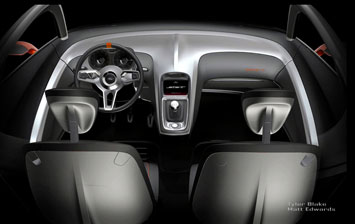 By integrating an ergonomically correct comfort curve and the optimal driving position, the seats were able to be thin and comfortable.
By integrating an ergonomically correct comfort curve and the optimal driving position, the seats were able to be thin and comfortable.
With snap-fitting inserts, the seat material and color allows for easy customization by the owner.
The direction was to add to the purity and philosophy of the rest of the car by creating signature seating and headliner treatments that are unique. That uniqueness and purity extends to every area of the Ford Start Concept.
The Ford Start Concept also offers a personal trunk compartment. The trunk saves weight, gives more room to the rear passengers and provides a secure place for possessions.
Interior design
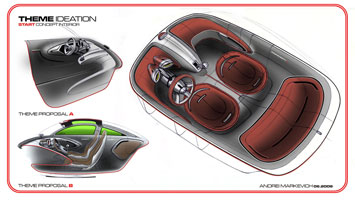 The minimalist approach extends into the interior of Ford Start Concept with a simplistic, twin cockpit, “tub” design that provides seating for up to four occupants.
The minimalist approach extends into the interior of Ford Start Concept with a simplistic, twin cockpit, “tub” design that provides seating for up to four occupants.
The tub interior provides a unique appearance, higher quality and reduced cost through its simplified, one piece construction.
The instrument panel includes a pod-type cluster that easily converts to both left- and right-hand drive versions.
The sweeping instrument panel and console are constructed with a single modular trim piece that starts at the base of the windshield and flows through the bottom of the centre console.
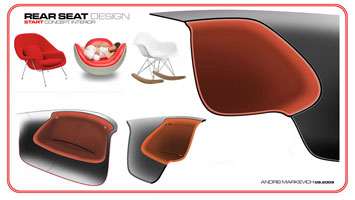 The five-speed manual transmission shift lever is centrally located up high in the console. Window switches and the push button start feature are located in the centre console and provide easy accessibility for either right- or left-hand drivers.
The five-speed manual transmission shift lever is centrally located up high in the console. Window switches and the push button start feature are located in the centre console and provide easy accessibility for either right- or left-hand drivers.
Seats, while simple, have been ergonomically designed to provide maximum comfort, personal flexibility and easy access to the rear.
A mono-rail seat pedestal allows fore and aft movement and allows for access to the rear seats.
Constructed with a composite shell to reduce weight, moulded seat inserts are designed to snap into the seat shell and are interchangeable to suit driver preference.
 The rear seating area also is constructed with a one piece mould and includes a removable seat insert.
The rear seating area also is constructed with a one piece mould and includes a removable seat insert.
Moulded rubber is used on the floor, consistent with the simplified approach to the interior. The mat is durable and can be cleaned easily.
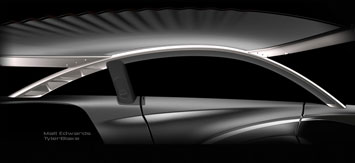
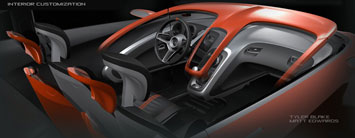
Rails and pillars throughout the interior are constructed of aluminium and fitted with side curtain airbags.
HMI – Human Machine Interface
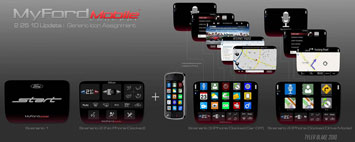 Located at the top of the console is a port to connect to the MyFord Mobile concept technology, which provides a seamless driver interface conducive to safe driving practices with personal handheld devices.
Located at the top of the console is a port to connect to the MyFord Mobile concept technology, which provides a seamless driver interface conducive to safe driving practices with personal handheld devices.
Without a smart phone, car-related functions including heating, ventilation and air conditioning (HVAC), engine diagnostics and passenger airbag on/off function can be easily viewed and adjusted while driving through either voice activation or toggle and scroll controls located on the console. A wide, six-inch screen provides visuals.
As an added feature, when the driver inserts a smart phone in the docking station when the vehicle is in motion, access is available via the MyFord Mobile Concept to phone contacts and navigation tools through voice activation, as are all messaging, direction and communication features.
If the smart phone device is docked and the vehicle is parked and powered off, both the vehicle functions and icons from the user’s device are available via the MyFord Mobile Concept. Icons are displayed on the large screen through Bluetooth transfer. Car functions and the speaker system also are controlled through voice activation.
MyFord Mobile Concept restricts certain functions, such as texting, while driving.
To help owners keep up with the latest trends and developments in personal electronics, the MyFord Mobile Concept is intended to be flexible, and can be adapted to suit changing mobile phone technology or driver preferences.
